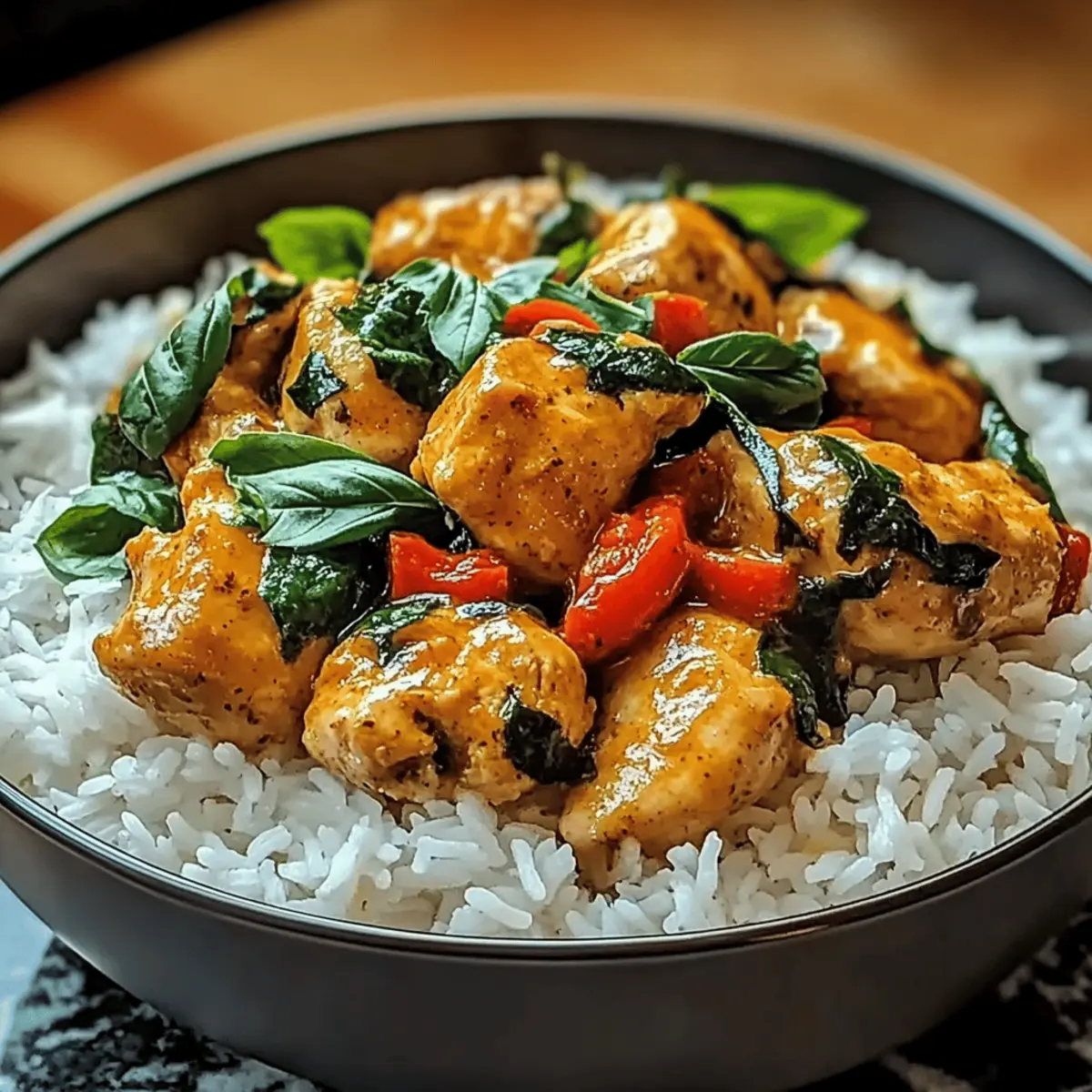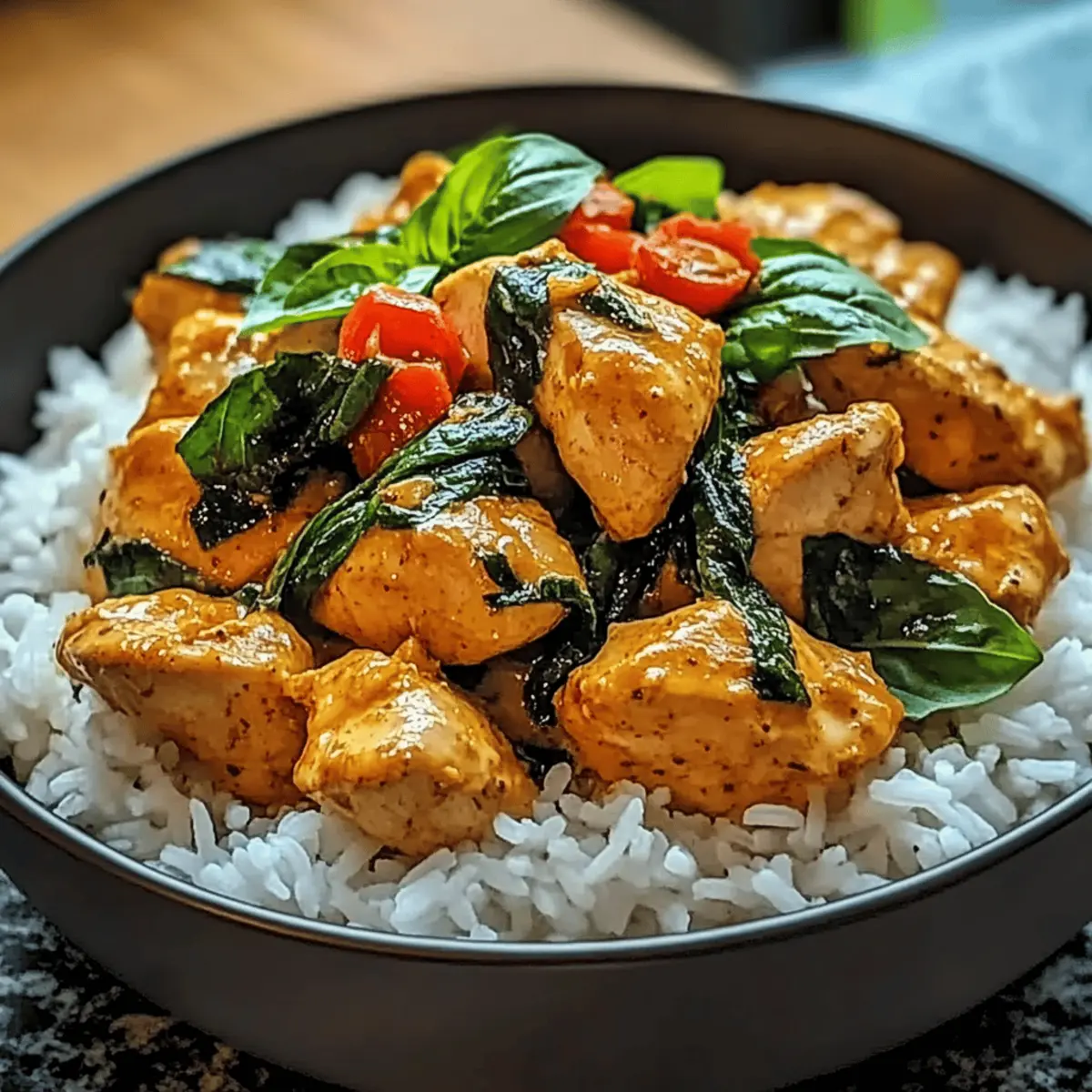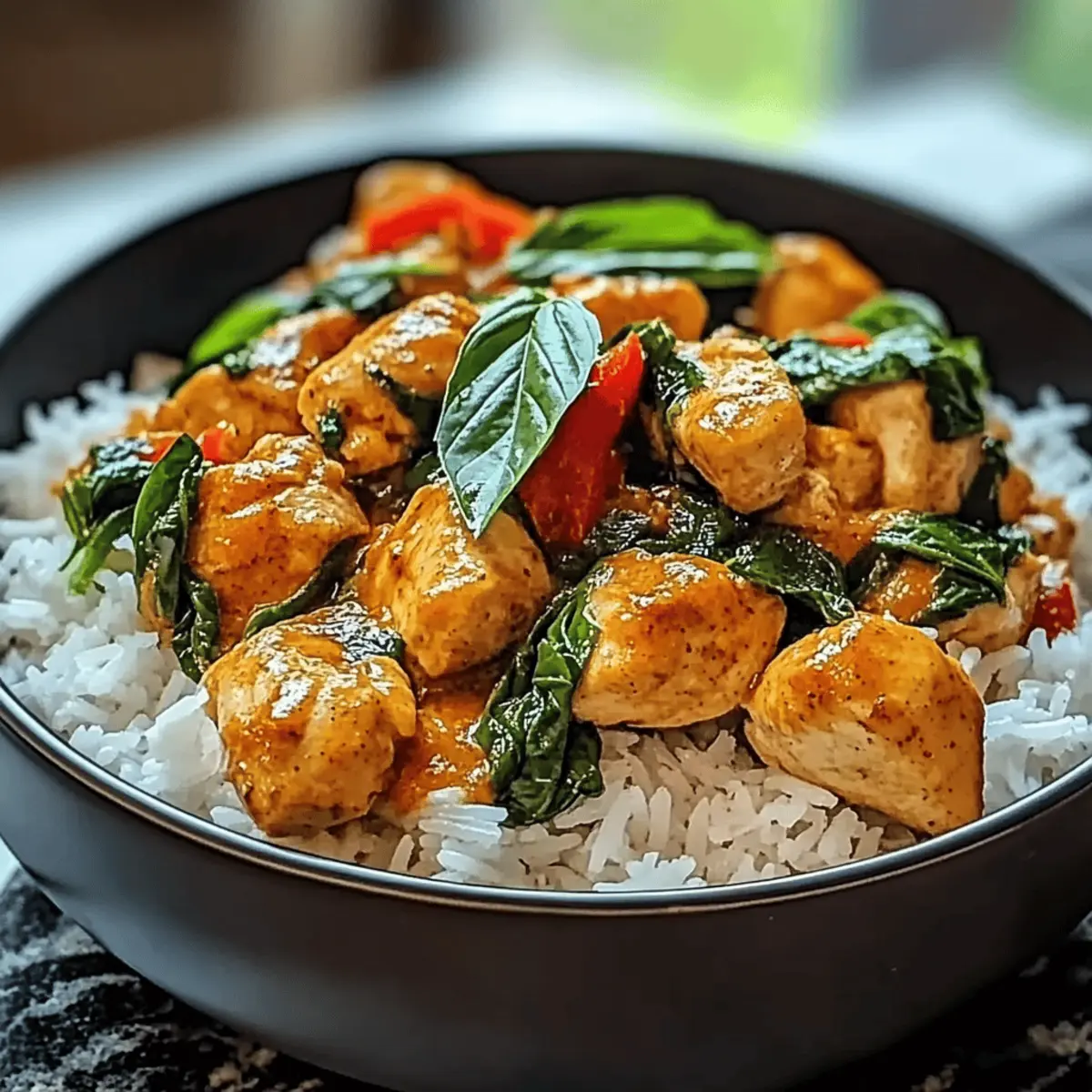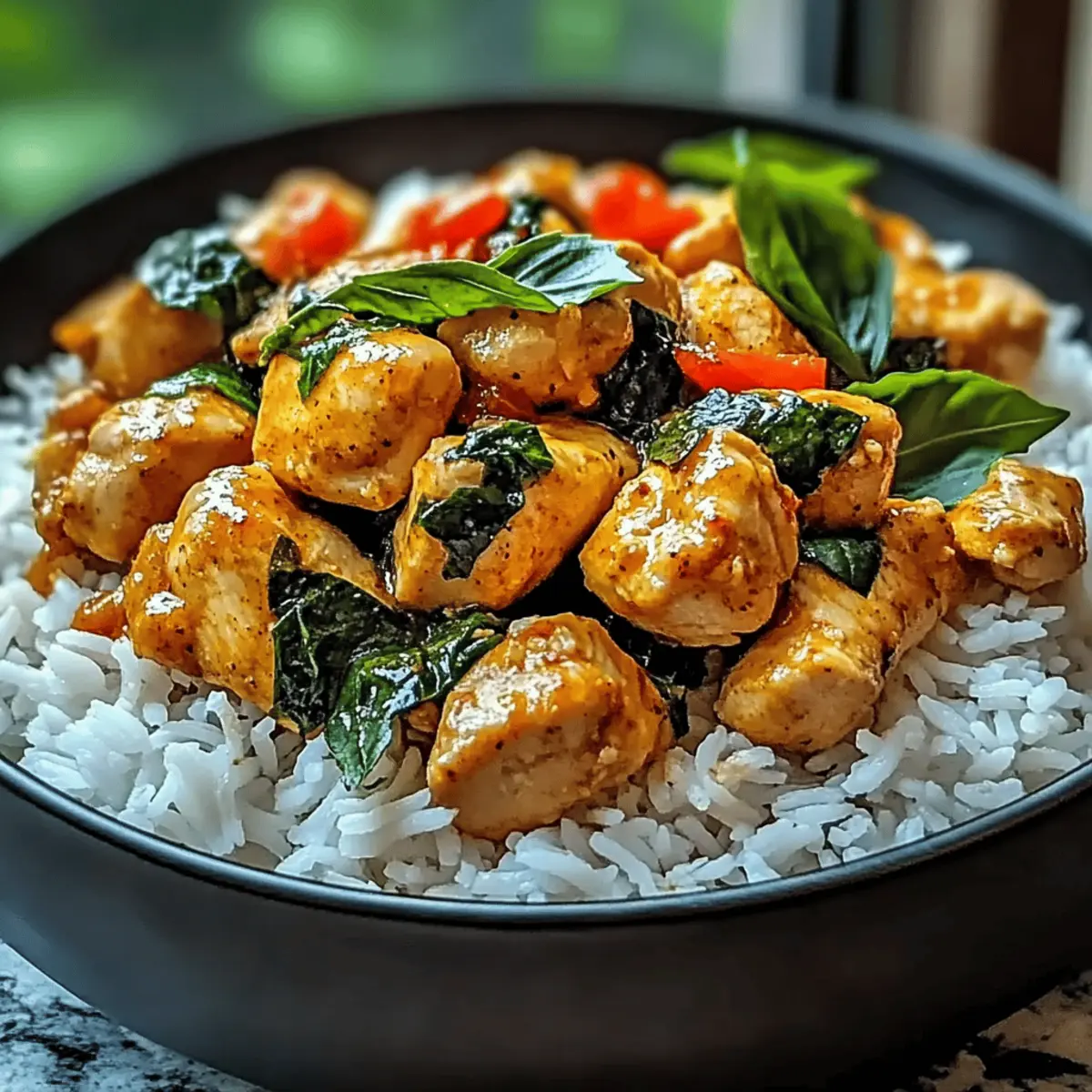As I stirred together the warm, fragrant spices and creamy coconut milk, the kitchen transformed into my tropical getaway. This Spiced Coconut Basil Chicken with Rice isn’t just a meal; it’s a quick dinner that whisks you away to sun-kissed shores even on the busiest of weeknights. This versatile dish is effortlessly customizable—it’s perfect for solo cooking as well as serving family and friends, easily accommodating both meat lovers and vegetarians alike. With just a few ingredients, you’ll whip up a satisfying and aromatic feast that pairs beautifully with fluffy rice and zesty lime. Who knew that a little spice and coconut could bring such joy to your dinner table? Are you ready to dive into this culinary adventure?

Why Is This Coconut Basil Chicken a Must-Try?
Simplicity: The recipe allows you to create a stunning meal with just a handful of accessible ingredients, making it perfect for busy weeknights.
Tropical Vibes: Each bite transports you to a tropical paradise with the creamy coconut milk and fresh basil working their magic.
Customizable: Whether you’re a meat lover or prefer a vegetarian option, this dish caters to all—swap chicken for tofu or chickpeas.
Flavor Explosion: The warm spices and zesty lime create a flavor profile that elevates your dining experience without much effort.
One-Pan Wonder: You can save time on cleanup by cooking everything in one pan, making it a convenient choice for any home cook.
Crowd-Pleaser: Perfect for small gatherings or a family dinner, this dish is a guaranteed hit that will impress guests and satisfy loved ones. If you’re looking for something else to excite your palate, check out my Korean Chicken Bao or try these delightful Chicken Empanadas.
Coconut Basil Chicken Ingredients
• For the Chicken
- Boneless, Skinless Chicken Breasts – Main protein for the dish; can swap with tofu or chickpeas for a vegetarian option.
- Olive Oil – Essential for cooking the chicken; feel free to use any cooking oil you prefer.
• For the Flavor Base
- Onion – Adds sweetness and depth; yellow or white onions work best.
- Garlic – Provides an aromatic punch; fresh garlic is recommended for optimal flavor.
- Ginger – Adds warmth and a hint of spiciness; fresh ginger is ideal, but ground can be used if needed.
- Ground Cumin & Ground Coriander – Spices that provide earthiness; tweak the amounts based on your taste preference.
- Turmeric – Adds vibrant color and beneficial properties; use fresh or ground for best results.
- Chili Powder – Introduces heat; adjust to your liking for spice levels.
• For the Sauce
- Coconut Milk – Key for a creamy sauce; opt for full-fat for a richer flavor.
- Chicken Broth – Adds moisture and depth; substitute with vegetable broth for a vegetarian dish.
• For the Finishing Touch
- Fresh Basil – Essential for a burst of freshness and aroma; dried basil can be used in a pinch, but fresh offers the best flavor.
- Lime Juice – Balances the dish with acidity; always go for freshly squeezed lime juice.
• For Serving
- Rice – The perfect base to soak up the delicious sauce; choose from white, brown, jasmine, or even cauliflower rice for a low-carb alternative.
With this easy-to-follow Coconut Basil Chicken ingredient list, you’re set to create a tropical flavor sensation right in your own kitchen!
Step‑by‑Step Instructions for Coconut Basil Chicken
Step 1: Cook the Rice
Start by preparing the rice according to the package instructions; typically, this involves rinsing the rice and cooking it in boiling water or broth for about 15-20 minutes. Once the rice is fluffy and cooked to perfection, set it aside, covered, to keep it warm and ready to soak up the delicious sauce from the Coconut Basil Chicken.
Step 2: Sauté the Chicken
In a large skillet, heat a tablespoon of olive oil over medium heat until shimmering. Season the boneless, skinless chicken breasts with salt and pepper, then carefully add them to the skillet. Cook each side for about 6-7 minutes, or until golden brown and cooked through, with an internal temperature of 165°F. Remove the chicken and set aside on a plate.
Step 3: Prepare the Flavor Base
Using the same skillet, add another splash of olive oil if needed, then toss in the chopped onion. Sauté for about 3-4 minutes until the onion is translucent and fragrant. Next, add minced garlic and grated ginger, stirring for an additional minute until aromatic. This step builds the foundation for the savory Coconut Basil Chicken sauce.
Step 4: Add the Spices
Sprinkle in the ground cumin, ground coriander, turmeric, and chili powder, stirring constantly for 1-2 minutes. The spices will bloom and release their flavors into the oil, creating an aromatic mix. You’ll notice a vibrant color and fragrance filling your kitchen—this is the heart of your Coconut Basil Chicken’s flavor.
Step 5: Combine Liquids
Pour in the creamy coconut milk and chicken broth, scraping the bottom of the skillet to lift any flavorful bits stuck to the pan. Stir gently to combine, allowing the mixture to come to a gentle simmer. The sauce should become luscious and creamy, perfect for enveloping the chicken later.
Step 6: Return Chicken to Sauce
Add the browned chicken back into the skillet, ensuring it’s nestled within the rich coconut sauce. Let it simmer for about 5 minutes on low heat, allowing the chicken to absorb the spices and flavors from the sauce. Keep an eye on it, ensuring it stays moist and tender while cooking.
Step 7: Finish with Fresh Ingredients
Just before serving, stir in the fresh basil leaves and a splash of lime juice to brighten the Coconut Basil Chicken dish. Adjust the seasoning if necessary, adding more salt or lime to taste. The vibrant colors and fragrant herbs will make this dish irresistible and inviting to your dinner table.
Step 8: Serve and Enjoy
Spoon the Coconut Basil Chicken over the warm rice you’ve prepared earlier. Garnish with extra basil or a wedge of lime for an appealing touch. The combination of creamy sauce and fluffy rice creates a satisfying meal that’s not just quick to prepare but truly a delightful tropical escape.

What to Serve with Spiced Coconut Basil Chicken with Rice
There’s nothing quite like a tropical dinner that tantalizes the senses and transports you to sun-soaked shores right from your kitchen.
-
Crispy Green Salad: Light and refreshing, this adds a crunch that balances the richness of the chicken. Toss in a zesty vinaigrette for an extra kick.
-
Mango Salsa: This tropical twist brightens the plate, offering a sweet and spicy contrast that complements the spices in your Chicken.
-
Coconut Rice: Enhance the coconut flavor by preparing fluffy rice using coconut milk instead of water. It absorbs and elevates the dish to a whole new level.
-
Roasted Vegetables: Colorful, caramelized veggies bring earthiness and sweetness to your meal—think bell peppers, zucchini, and snap peas. They’re not only nutritious but delicious too!
-
Grilled Pineapple: The warmth of the grill caramelizes natural sugars, creating a delightful side that pairs excellently with coconut flavors and adds a stunning visual appeal.
-
Chilled White Wine: A crisp, chilled Sauvignon Blanc or Pinot Grigio complements the tropical essence of the dish, adding a sophisticated touch to your dinner.
-
Lime Sorbet: For dessert, serve this light, refreshing option to cleanse the palate after the savory chicken. It echoes the zesty lime in the dish.
Perfecting these pairings not only enhances your dining experience but also allows everyone at the table to savor every moment!
Expert Tips for Coconut Basil Chicken
- Perfectly Cooked Chicken: Avoid overcooking by using a meat thermometer; chicken should reach 165°F for maximum tenderness.
- Marinate for Flavor: Enhance the chicken’s taste by marinating it for at least 30 minutes with garlic, ginger, and a splash of lime juice.
- Quality Coconut Milk: Choose high-quality full-fat coconut milk to achieve a rich, creamy sauce that makes the dish truly indulgent.
- Add Fresh Basil Last: To preserve its vibrant flavor and aroma, add fresh basil just before serving instead of cooking it in.
- Rice Cooking Tips: Avoid mushy rice by rinsing it beforehand and following package instructions closely for the perfect texture.
- Versatile Heat Levels: Adjust the chili powder to suit your taste; start with a smaller amount and increase gradually for the ideal spice level in the Coconut Basil Chicken.
Make Ahead Options
These Spiced Coconut Basil Chicken with Rice are ideal for busy weeknights and meal prep! You can marinate the chicken with spices and lime juice up to 24 hours in advance to enhance flavor. Cook the rice and let it cool completely, then store it in the refrigerator for up to 3 days. Additionally, you can prepare the sauce (steps 3-5) and refrigerate it for up to 3 days as well. To maintain quality, keep each component in airtight containers and combine everything in a skillet when ready to serve. Simply reheat the chicken and sauce over medium heat until warmed through, serve over rice, and enjoy a delicious meal that feels freshly made!
How to Store and Freeze Coconut Basil Chicken
Fridge: Keep your Coconut Basil Chicken in an airtight container for up to 3 days. Store the rice separately to maintain its texture.
Freezer: For longer storage, freeze the chicken and sauce in airtight containers for up to 2 months. Avoid freezing cooked rice, as it tends to become mushy.
Reheating: To enjoy your Coconut Basil Chicken again, thaw it overnight in the fridge, then gently reheat on the stove over low heat. Add a splash of coconut milk if the sauce has thickened.
Serving Tip: For freshness, reheat and serve the chicken over freshly cooked rice, enhancing the overall flavor and experience.
Coconut Basil Chicken Variations
Feel free to play with this recipe and make it your own—let your creativity flow and add your favorite flavors!
-
Vegetarian Option: Substitute chicken with tofu or chickpeas for a delightful vegetarian twist. Both options absorb flavors beautifully and satisfy cravings.
-
Heat Level Up: Increase the chili powder or toss in fresh chilies for a spicier punch. If you love heat, don’t be shy to test your limits!
-
Veggie Boost: Add fresh vegetables like bell peppers, zucchini, or spinach for added nutrition and a pop of color. They’ll cook quickly and enhance the dish’s overall freshness.
-
Grain Switch: Opt for quinoa instead of rice for a nutty flavor and a high-protein alternative. This switch adds an extra twist with a delightful texture.
-
One-Pan Wonder: Combine the rice and chicken in the same skillet for a one-pan meal that makes cleanup a breeze. It simplifies preparation without sacrificing flavor.
-
Coconut Milk Alternatives: If you’re looking for a lighter option, try using light coconut milk. It will alter the richness slightly but still provide that tropical goodness.
-
Flavor Enhancements: Add a splash of fish sauce or soy sauce for deeper umami notes that will take this dish to new heights. A little goes a long way!
For additional inspiration, don’t forget to check out my Garlic Parmesan Chicken for a creamy twist or spice it up with some Black Pepper Chicken for an irresistible flavor journey!

Coconut Basil Chicken Recipe FAQs
What type of chicken is best for this recipe?
For the best results, use boneless, skinless chicken breasts as they cook quickly and remain tender. However, for a vegetarian option, you can easily swap the chicken for tofu or chickpeas, which soak up the delicious sauce beautifully.
How should I store leftover Coconut Basil Chicken?
Refrigerate your Coconut Basil Chicken in an airtight container for up to 3 days. Be sure to store the rice separately to keep its texture intact. When you’re ready to enjoy it again, reheat gently on the stove or in the microwave, adding a splash of coconut milk if the sauce thickens.
Can I freeze Coconut Basil Chicken?
Absolutely! For freezing, let the chicken and sauce cool completely, then transfer them to airtight containers or freezer bags. It can be frozen for up to 2 months. I suggest avoiding freezing cooked rice, as it may become mushy upon thawing. To reheat, simply thaw overnight in the fridge and warm gently on the stove.
What should I do if the sauce is too thick?
If you find your sauce has thickened too much, don’t worry! Just add a splash of coconut milk or chicken broth while reheating; stir well to combine. This will help restore its creamy consistency and enhance the flavor.
Can I make adjustments for dietary restrictions?
Yes! This Coconut Basil Chicken recipe is very versatile. If you’re vegetarian, replace the chicken with tofu or chickpeas. For gluten-free options, ensure your chicken broth is gluten-free. Always check labels for potential allergens, especially with spices or packaged ingredients.
What if I want to make it spicier?
If you enjoy a kick, feel free to increase the chili powder or add fresh chilies to the dish. You can start by adding an extra teaspoon, then taste and adjust further if needed. Just remember, the more the merrier when it comes to heat!

Coconut Basil Chicken: Your New Favorite Tropical Comfort Food
Ingredients
Equipment
Method
- Cook the rice according to the package instructions; typically, this involves rinsing the rice and cooking it in boiling water or broth for about 15-20 minutes.
- In a large skillet, heat a tablespoon of olive oil over medium heat until shimmering. Season the chicken breasts with salt and pepper, then add them to the skillet. Cook each side for about 6-7 minutes, until golden brown and cooked through, with an internal temperature of 165°F.
- Using the same skillet, add another splash of olive oil if needed, then toss in the chopped onion. Sauté for about 3-4 minutes until translucent.
- Add minced garlic and grated ginger, stirring for an additional minute until aromatic.
- Sprinkle in the ground cumin, ground coriander, turmeric, and chili powder, stirring constantly for 1-2 minutes.
- Pour in the coconut milk and chicken broth, scraping the bottom of the skillet. Stir gently to combine and simmer.
- Add the browned chicken back into the skillet, ensuring it's nestled within the sauce. Let it simmer for about 5 minutes.
- Stir in the fresh basil leaves and lime juice just before serving.
- Serve the Coconut Basil Chicken over the prepared rice, garnished with extra basil or a wedge of lime.

Leave a Reply